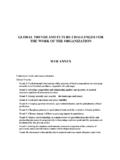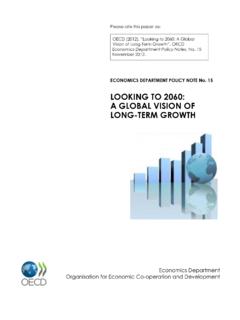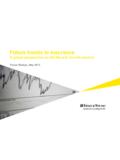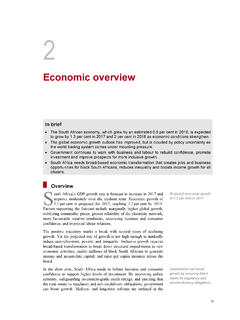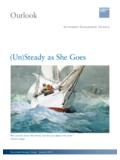Transcription of Key dates in financial history--DRAFT
1 1 Key dates in financial history Edited by Kurt Schuler (e-mail: 8 May 2011 Suggested citation to this file Kurt Schuler, editor, Key dates in financial history , original version 8 May 2011; viewed on [ date of viewing] at Historical financial Statistics Web site, The purpose of this file is to give an idea of the most significant developments in world financial history from the origin of paper money until today. It focuses on the economies that have issued the world s key currencies. Red lettering indicates important firsts. I welcome comments. 995: First paper notes issued privately in China, constituting the first free banking system (where banks issued notes and deposits competitively, without centralized control of the monetary base). By 1214: First tradable government bonds issued in Genoa. 1408: Casa delle compere e dei banchi di San Giorgio, established in 1407, becomes Europe s first modern bank.)
2 Late 1400s: Silver production in central Europe increases, beginning the price revolution of inflation of roughly 2 percent a year that lasts into the early 1600s, spurred by silver discovered in the Americas after European deposits taper off. 1492: Columbus discovers the Americas; European colonization begins soon afterwards, bringing with it the European monetary systems of the time. 1497-1498: Vasco de Gama finds a passage to India around the Cape of Good Hope. European colonization of South Asia begins soon afterwards, bringing with it European monetary systems. 1519-1522: Ferdinand Magellan and his crew sail around the world. The world is now at least potentially a single market. 1526: Discovery of Iwami silver seams in Japan, an event of regional significance. 1545: Discovery of the Potos silver mountain in present-day Bolivia, an event of global significance for the supply of the metal.
3 Another major discovery of silver occurs in Zacatecas, Mexico in 1546. Both places are Spanish possessions. The Spanish silver pesos (also known as silver dollars) minted from these discoveries become the premier international currency of the 1600s and 1700s. 1555: Marked edges for coins devised, the first of a series of innovations to reduce mutilation. 1575: French copper coins become apparently the first true Western token coins minted on a long-term basis, though there had been experiments before. (In China, token coins were many centuries older.) 1602: First organized stock (equity) exchange, in Amsterdam. 1650: First futures contracts, at the Yodoya rice market in Osaka, Japan, about this year. 1656: Stockholm Banco issues the first paper notes in Europe. 1667: The Insurance Office, the first insurance company, is established in London. 2 1668: Bankrupt Stockholm Banco loses its charter.
4 The Swedish parliament establishes the world s first central bank, Riksens St nders Bank (today Sveriges Riksbank [Bank of Sweden]). 1680: Major discovery of gold in Minas Gerais, Brazil. 1694: English government establishes the Bank of England as a quasi-central bank. 1704: Russia becomes the first Western country to adopt decimal coinage. (China had long had a somewhat decimalized coinage.) The United States begins minting decimal coins in 1792. Other countries do not follow until later; the United Kingdom, the last major holdout, decimalizes in 1971. 1717: United Kingdom adopts the gold standard in practice as a result of the mint ratio of gold to silver chosen by mint master Isaac Newton. 1719-1720: Mississippi Company bubble and inflation in France; South Sea Company bubble in England. 1756-1763: Seven Years War, which causes France to lose most of its colonies of the time and results in a corresponding shrinkage of the French currency zone.
5 1768: Russian government establishes an Assignat Bank to issue paper money. The State Bank of Russia, more of a modern-style central bank, is established in 1860. 1774: First mutual fund, in the Netherlands. 1775: First bank clearing house, in London. 1789-1815: Revolution and hyperinflation in France, rise and fall of Napoleon, frequent wars in Europe and by extension in European colonies. 1780: First inflation-indexed bonds issued, in Massachusetts. 1789-1796: First Western hyperinflation, in France, resulting from excessive issue of government notes (paper money). China had several episodes of high inflation, perhaps including hyperinflation, well before this. 1791: The Bank of the United States, partly owned by the federal government, is established; its charter is not renewed in 1811, but a second Bank of the United States exists from 1816 to 1836. Both banks have some quasi central banking functions.
6 1797: United Kingdom suspends the convertibility of the pound sterling into gold. 1800: Bank of France established as France s central bank. Unlike its counterpart the Bank of England, it does not suspend convertibility into gold during the Napoleonic Wars. 1803: France adopts a bimetallic standard at a silver-to-gold ratio of :1. 1810: During the Napoleonic Wars, Spanish colonies in the Americas start breaking away from Spain. The independent states issue their own coins, often differing in silver content from the internationally accepted Spanish silver peso. 1816: United Kingdom adopts the monometallic gold standard by law, though in practice the exchange rate fluctuates until 1819. From about this time, the pound sterling becomes the premier international currency, displacing the Spanish silver peso. 1825: financial crisis in England, the United States, and Latin America.
7 1834: United States adopts the gold standard de facto as a result of the mint ratio of gold to silver it chooses, although gold will not become the single, unambiguous standard until 1900. 1836-1837: financial crisis in England and the United States. 1844: Bank of England becomes a monopoly note issuer and full-fledged central bank. Its example influences many other countries in the coming decades. First use of the telegraph for long-distance communication (Baltimore to Washington, ). The telegraph quickly becomes essential to international financial markets. 3 1847-1848: financial crisis in England and United States, then revolutions in several continental European countries and resulting financial turmoil. The Bank of France becomes a monopoly note issuer and a full-fledged central bank. 1849: California gold discoveries; gold is also discovered in Australia, in 1851.
8 1857: financial crises in United Kingdom, United States, Scandinavia, and Hamburg. 1859: Comstock Lode of silver discovered in Nevada, United States. 1861: United States abandons the gold standard during the Civil War. 1865: France, Belgium, Switzerland, and Italy form the Latin Monetary Union on the basis of the French monetary standard. 1866: financial crises in England, India, Italy, Spain, and Germany. 1873: Germany switches from a silver standard to a gold standard, beginning a chain of events that ends with most former silver standard or bimetallic countries switching to gold alone over the next 30 years. The United States in effect enacts the gold standard into law, though in practice the exchange rate floats until 1879. financial crises in Germany, Austria, and United States. 1875: Deutsche Reichsbank established as Germany s central bank. 1882: Bank of Japan established as Japan s central bank.
9 1885: General Act of the Conference of Berlin divides Africa among Belgium, France, Germany, Italy, Portugal, Spain, and the United Kingdom; by about 1905 they exert full power over Africa s interior, bringing with them European monetary systems. 1886: Gold discovered in South Africa. As South African gold reaches the market in large amounts in later years, what had been been a deflation for countries on the gold standard became a modest inflation. 1890: Baring Brothers crisis in England, Argentina, and Uruguay; financial panic in the United States. 1893: financial crises in Australia, Germany, Italy, and the United States. 1895: Japan s annexation of Taiwan after war with China begins an expansion of the Japanese monetary zone that continues by steps until the middle of World War II. The zone eventually also includes Korea, Manchuria, coastal China, Oceania, and Southeast Asia.
10 1907: financial crises in the United States, Chile, Denmark, Egypt, Italy, Japan, Sweden, and, to a lesser extent Canada, France, Germany, and the Netherlands. First modern securitization, a mortgage bond with a senior tranche, by Samuel W. Straus, in New York City. 1914: Federal Reserve System established as the central bank of the United States. 1914-1918: World War I. All belligerent countries and many others suspend their gold or silver standards, marking the beginning of the end of full-bodied gold and silver coins. The war begins the rise of the dollar as an international currency of roughly equal importance as the pound sterling. 1917: Russian revolutions. After the October Revolution, the Bolsheviks begin the first attempt to establish a centrally planned economy, where money plays a much different role than it does in a market economy. 1918-1920: Various treaties strip Germany, Austria, Turkey, and Russia of territory they had before World War I, creating many new countries in Central Europe and the Middle East.



